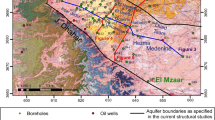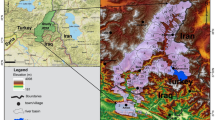Abstract
This paper investigates the use of hydromorphometric parameters and new maps and classification of landforms to characterize hydrological forms over the regional scale. This methodology was applied on a very large fractured carbonate aquifer located in the Musandam Peninsula, UAE and Oman. These hydrological forms are drainage basins, drainage network and flow accumulation, and transit and dissipation zones. These forms match in physical entities and are of real importance. Bivariate quadratic surfaces with moving window size of 3 × 3 were fitted to the DEM. The first derivative, slope steepness, and the second derivatives, minimum and maximum curvatures, were calculated as hydromorphometric parameters used to map and characterize hydrological forms at multiscale level. These, however, can be plotted into graphs of characterization and classification that comprise hydromorphometric signatures. The Landsat images, groundwater wells distribution, and spatial analysis of hydromorphometric parameter signatures allowed the assignment of the obtained results. The results revealed that this approach allowed a quick mapping and estimation of the spatial distribution of hydromorphometric parameters in a highly fractured karst regional aquifer.









Similar content being viewed by others
References
Abu Al Enien H (1996) Wadi Al Bih alluvial fan water resources (publ. no. 198). Kuwait University, Geography Department, p 78
Adediran AO, Parcharidis I, Poscolieri M, Pavlopoulos K (2004) Computer-assisted discrimination of morphological units on north-central Crete (Greece) by applying multivariate statistics to local relief gradients. Geomorphology 58:357–370
Al Wahedi AA (1997) Application of hydrogeochmistry and groundwater modeling techniques for assessment of water resources of Wadi Al Bih drainage basin, Rasv Al Khaimah Area, United Arab Emirates. MSc Thesis, UAE University, Al Ain, United Arab Emirates
Blaschke T, Strobl J (2003) Defining landscape units through integrated morphometric characteristics. In: Buhmann E, Ervin S (eds) Landscape modeling: digital techniques for landscape architecture. Wichmann, Heidelberg, pp 104–113
Burrough PA, McDonnell RA (1998) Principles of geographical information systems. Oxford University Press, Oxford
Doll P, Lehner B, Kaspar F (2002) Global modeling of groundwater recharge. Hydrol Earth Syst Sci 12:863–885
Ehsani AH, Quil F (2008) Application of self organizing map and SRTM data to characterize yardangs in the Lut desert. Iran Remote Sens Environ 112:3284–3294
Electrowatt Engineering (1981) Wadi Al Bih dam and groundwater recharge facilities. Min Agric Fish 1:67
Evans IS (1972) General geomorphometry, derivatives of altitude, and descriptive statistics. In: Chorley RJ (ed) Spatial analysis in geomorphology, Durham University, England, Department of Geography, p 17–90
Finzi V (1973) Late quaternary subsidence in the Musandam expedition, 1971–1972, scientific results, part I. Geogr J 139:414–421
Florinsky IV (1993) Digital elevation model analysis for linear landsurface structure recognition. Abstract of Ph.D. thesis. Moscow State University of Geodesy and Cartography, Moscow 17 pp., in Russian
Florinsky IV (2000) Relationships between topographically expressed zones of flow accumulation and sites of fault intersection: analysis by means of digital terrain modelling. Environ Model Softw 15:87–100
Ghoneim E (2007) Optimum groundwater locations in the northern United Arab Emirates. Int J Remote Sens 29(20):5879–5906
Glennie KW, Boeuf MG, Hughes CM, Moody-Stuart M, Pilaar WF, Reinhardt BM (1974) Geology of the Oman Mountains, parts 1 and 2. The Royal Dutch Geological and Mining Society (KNGMG), Utrecht, The Netherlands, 423 pp
Guth PL (2008) Geomorphometry in MICRODEM. In: Hengl T, Reuter HI (eds) Geomorphometry: concepts, software, applications, Developments in soil science series. Elsevier, New York, pp 351–366, ISBN-13: 978-0-12-374345-9
Hengl T, Rossiter D (2003) Supervised landform classification to enhance and replace photo-interpretation in semi-detailed soil survey soil. Sci Soc Am J 67:1810–1822
Hengl T, Gruber S, Shrestha D (2003) Digital terrain analysis in ILWIS, lectures notes and user guide. International Institute for Geo-information Science and Earth Observation, Enschede
Irvin BJ, Ventura SJ, Slater BK (1997) Fuzzy and isodata classification of landform elements from digital terrain data in Pleasant Valley, Wisconsin. Geoderma 77:37–154
Jenson S, Domingue J (1988) Extracting topographic structure from digital elevation model data for geographic information system analysis. Photogramm Eng Remote Sens 54:1593–1600
Kansoh R, Muller WM, Klingbeil R (2003) Management of shared groundwater. United Nations Economic and Social Commission for Western Asia, Hannover, 11/09/2003
Kirkby MJ, Chorley RJ (1967) Through flow, overland flow and erosion. Bull Int Assoc Sci Hydrol 12:5–21
Lukin AA (1987) Experience in development of morphostructural and hydrological analysis technique. Nauka, Novosibirsk, 111 pp., in Russian
Ministry of Environment and Water (MEW) (1993) United Arab Emirates (UAE) hydrology, vol 3. Department of Soil and Water, Abu Dhabi, 294 pp
Moore ID, Gessler PE, Nielsen GA, Peterson GA (1993) Terrain analysis for soil specific crop management. In: Robert PC, Rust RC, Larson WE (eds) Proceedings of first workshop, soil specific crop management. Soil Science Society of America, Madison
Poletaev AI (1992) Fault intersections of the earth crust. Geoinformmark, Moscow, 50 pp., in Russian
Samy I (2006) Remote sensing for hydrological application in the vacinity of Al Dhaid, UAE. M.Sc, University Technology Malaysia (UTM)
Elmahdy S, Mohamed M (2012) Influence of geological structures on groundwater accumulation and groundwater salinity in Musandam Peninsula, UAE and Oman. Geocarto Int J 28(5):453–472
Elmahdy S, Mohamed M (2013a) Remote sensing and GIS applications of surface and near-surface hydromorphological features in Darfur region, Sudan. Int J Remote Sens 34(13):4715–4735
Samy IE, Mohamed MM (2013b) Relationship between geological structures and groundwater flow and groundwater salinity in Al Jaww Plain, UAE; mapping and analysis by means of remote sensing and GIS. Arab J Geosci. doi:10.1007/s12517-013-0895-4
Samy IE, Mohamed MM (2013c) Groundwater potential modelling using remote sensing and GIS: a case study of the Al Dhaid area, United Arab Emirates. Geocarto Int J. doi:10.1080/10106049.2013.784366
Elmahdy S, Mohamed M (2014a) Automatic detection of near surface geological and hydrological features and investigating their influence on groundwater accumulation and salinity in southwest Egypt using remote sensing and GIS. Geocarto Int 1–13. doi:10.1080/10106049.2014.883433
Elmahdy S, Mohamed M (2014b) Relationship between geological structures and groundwater flow and groundwater salinity in Al Jaaw Plain, United Arab Emirates; mapping and analysis by means of remote sensing and GIS. Arab J Geo 7:1249–1259
Schmidt J,AndrewR (2005)Multi-scale landformcharacterization Royal Geographical Society (with The Institute of British Geographers)
Shary PA (1995) Land surface in gravity points classification by complete system of curvatures. Math Geol 27:373–390
Shary PA, Kuryakova GA, Florinsky IV (1991) On the international experience of topographic methods employment in landscape investigations (a concise review). In: Stepanov IN (ed) The geometry of the earth surface structures. Pushchino Research Centre, Pushchino, in Russian
Shary PA, Sharaya SL, Mitusov AV (2002) Fundamental quantitative methods of land surface analysis. Geoderma 107:1–32
UAE national atlas (United Arab Emirates national atlas) (1993) Remote Sensing Center: UAE University, p. 188
Van Engelen VW, Wen TT (1995) Global and national soils and terrain digital databases (SOTER). Procedures manual (revised edn.). International Soil References and Information Centre, Wageningen
Wood JD (1996) The geomorphologic characterization of digital elevation models. PhD Dissertation, University of Leicester, UK
Acknowledgments
The author would like to thank Professor Peter Guth from USA Academic Navy, the Earth Remote Sensing Data Analysis Center (ERSDAC), Japan, the NASA Land Processes Distributed Active Archive Center and the User Services, USGS Earth Resources Observation and Science (EROS), and the Consortium for Spatial Information (CSI) of the Consultative Group for International Agricultural Research (CGIAR) for providing and distributing scientific advisers and remotely sensed data.
Author information
Authors and Affiliations
Corresponding author
Rights and permissions
About this article
Cite this article
Elmahdy, S.I. Application of hydromorphometric parameterization and ASTER DEM to characterize hydrological indicators in the Musandam Peninsula, UAE and Oman. Appl Geomat 7, 1–11 (2015). https://doi.org/10.1007/s12518-014-0143-y
Received:
Accepted:
Published:
Issue Date:
DOI: https://doi.org/10.1007/s12518-014-0143-y




